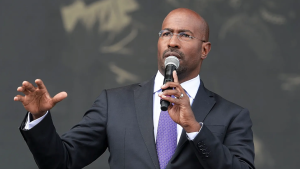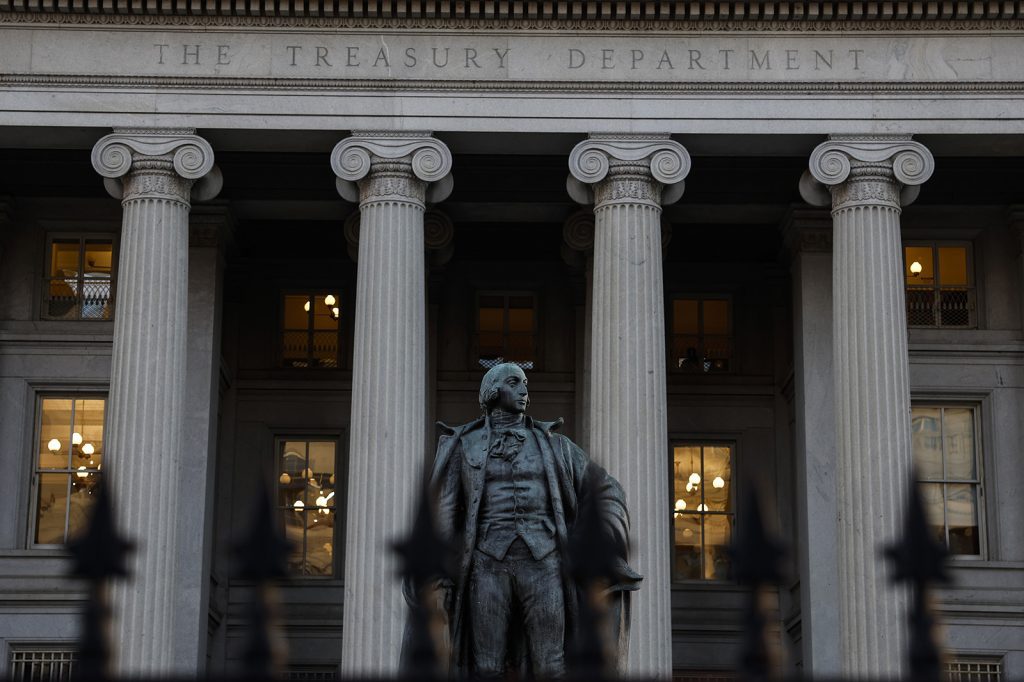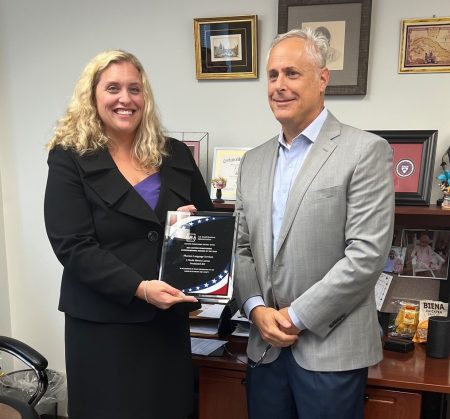By Bhargavi Sakthivel, Maeva Cousin and David Wilcox, Bloomberg News
The Congressional Budget Office cautioned in its most recent predictions that U.S. federal government debt is on a track from 97% of GDP last year to 116% by 2034 — higher even than in World War II. The actual forecast is likely worse.
From tax income to defense spending and interest rates, the CBO predictions released earlier this year are based on positive assumptions. Insert the market’s current view on interest rates, and the debt-to-GDP ratio increases to 123% in 2034. Then assume — as most in Washington do — that ex-President Donald Trump’s tax cuts mainly stay in place, and the burden gets even higher.
With uncertainty about so many of the variables, Bloomberg Economics has conducted a million tests to evaluate the fragility of the debt outlook. In 88% of the tests, the results show the debt-to-GDP ratio is on an unsustainable path — defined as an increase over the next decade.
The Biden administration says its budget, featuring a slew of tax increases on corporations and wealthy Americans, will ensure fiscal sustainability and manageable debt-servicing costs.
“I do believe we need to reduce deficits and to stay on a fiscally sustainable path,” Treasury Secretary Janet Yellen told lawmakers in February. Biden administration proposals offer “substantial deficit reduction that would continue to hold the level of interest expense at comfortable levels. But we would need to work together to try to achieve those savings,” she said.
Trouble is, delivering on such a plan will require action from a Congress that’s bitterly divided on partisan lines.Republicans, who control the House, want deep spending cuts to bring down the ballooning deficit, without specifying exactly what they’d slash. Democrats, who oversee the Senate, argue that spending is less of a contributor to any deterioration in debt sustainability, with interest rates and tax revenues the key factors. Neither party favors squeezing the benefits provided by major entitlement programs.
In the end, it may take a crisis — perhaps a disorderly rout in the Treasuries market triggered by sovereign U.S. credit-rating downgrades, or a panic over the depletion of the Medicare or Social Security trust funds — to force action. That’s playing with fire.
Last summer provided a foretaste, in miniature, of how a crisis might begin. Over two days in August, a Fitch Ratings downgrade of the U.S. credit rating and an increase of long-term Treasury debt issuance focused investor attention on the risks. Benchmark 10-year yields climbed by a percentage point, hitting 5% in October — the highest level in more than one and a half decades.
As for how things might end, Britain’s experience in fall 2022 provides a glimpse into the abyss. Then-Prime Minister Liz Truss’s plan for unfunded tax cuts sent the gilt market into a tailspin. Yields soared so quickly that the central bank had to step in to snuff out the risk of an outright financial crisis. The bond vigilantes’ actions forced the government to call off the plan and Truss out of office.
The dollar’s important role in global finance and its status as the main reserve currency make it unlikely for a similar crisis to happen in the U.S. It would be very difficult to make investors lose trust in U.S. Treasury debt as the safest asset. However, if that trust disappeared, it would be a significant moment, leading to the U.S. losing not only access to affordable funding but also international power and prestige.
Variable variables
How does the Congressional Budget Office, which is the official budget watchdog for Washington, make its debt prediction? The CBO’s assumptions for important factors like GDP growth around 2%, inflation going back to 2%, and interest rates decreasing from current levels are quite reasonable. They are also similar to the numbers in the Federal Reserve Bank of Philadelphia’s Survey of Professional Forecasters. In fact, the CBO’s view on rates is a little higher than the most recent agreement.
Examine them closely, though, and key assumptions supporting the CBO forecast seem optimistic:
- By law, the CBO is required to depend on existing legislation. This means it assumes the 2017 Trump tax cuts will end as planned in 2025. However, even President Joe Biden wants some of them to continue. According to the Penn Wharton Budget Model, making the legislation’s revenue provisions permanent would cost about 1.2% of GDP each year starting in the late 2020s.
- The CBO also has to assume that discretionary spending, which is decided by Congress every year, will rise with inflation, not keep up with GDP. As a result, defense spending decreases from around 3% of GDP now to about 2.5% in the mid-2030s — a difficult goal considering the ongoing wars and looming geopolitical threats. Former Treasury Secretary Lawrence Summers says a more realistic prediction would add at least 1% of GDP to the CBO’s forecast.
- Market participants don’t believe the positive rates outlook, as forward markets show borrowing costs much higher than what the CBO assumes.
Bloomberg Economics has created a forecast model using market pricing for future interest rates and data on the maturity profile of bonds. With all the other CBO assumptions unchanged, this shows debt reaching 123% of GDP by 2034. Debt at that level would mean servicing costs reach close to 5.4% of GDP — more than 1.5 times what the federal government spent on national defense in 2023, and similar to the entire Social Security budget.
Important figures from various political perspectives agree that the long-term prediction is worrying. Fed Chair Jerome Powell said earlier this year it was “probably time — or past time” for politicians to take action in dealing with the “unsustainable” path for borrowing. Former Treasury Secretary Robert Rubin said in January that the nation is in a “terrible place” in terms of deficits. From the financial sector, Citadel founder Ken Griffin informed investors in a letter that U.S. national debt is a “growing concern that cannot be overlooked.” Days earlier, BlackRock Inc. Chief Executive Officer Larry Fink stated that the U.S. public debt situation “is more urgent than I can ever remember.” Former IMF chief economist Kenneth Rogoff says while an exact “upper limit” for debt is unknowable, there will be challenges as the level keeps going up.
Rogoff’s main point is well understood: predictions are uncertain. To estimate the uncertainty, Bloomberg Economics has conducted a million simulations based on the CBO’s basic view — a method economists call stochastic debt sustainability analysis. Each simulation predicts the debt-to-GDP ratio using different levels of GDP growth, inflation, budget deficits, and interest rates, with variations based on historical data patterns.
In the worst 5% of scenarios, the debt-to-GDP ratio in 2034 exceeds 139%, which means that the U.S. would have a higher debt ratio in 2034 than crisis-prone Italy did last year.
Yellen has another way of looking at debt sustainability: inflation-adjusted interest expense, which she has indicated should be below 2% of GDP. On that basis, the findings are more optimistic — showing that the metric breaches the threshold in less than a third — 30% — of simulations over the next 10 years. The Treasury chief herself acknowledged in a Feb. 8 hearing that “in an extreme case” there could be a possibility of borrowing reaching levels that buyers wouldn’t be willing to purchase everything the government sought to sell. She added that she saw no signs of that now.
Partisan politics
Achieving a sustainable path will require action from Congress. Precedent isn’t promising. Disagreements over government spending reached a climax last summer, when a standoff over the debt ceiling brought the U.S. to the brink of a default. The deal to stop the chaos suspended the debt ceiling until Jan. 1, 2025, delaying another clash over borrowing until after the presidential election.
It’s difficult to imagine a U.S. debt crisis. The dollar is still the global reserve currency. The yearly and unpleasant spectacle of government-shutdown brinksmanship typically has little impact on the Treasury market.
However, the world is changing. China and other emerging markets are reducing the dollar’s role in trade invoicing, cross-border financing and foreign exchange reserves. Foreign buyers make up a gradually shrinking share of the U.S. Treasuries market, testing domestic buyers’ appetite for ever-increasing volumes of federal debt. And while demand for those securities has recently been supported by expectations for the Fed to lower interest rates, that dynamic won’t always be in play.
Herbert Stein — head of the Council of Economic Advisers in the 1970s — noted that “if something cannot go on forever, it will stop.” If the U.S. doesn’t get its fiscal house in order, a future U.S. president will have the truth of that maxim confirmed. And if confidence in the world’s safe asset evaporates, everyone will suffer the consequences.
Methodology
As a starting point for the analysis, Bloomberg Economics uses the baseline fiscal and economic outlook — including the effective interest rate, primary budget balance as a percent of GDP, inflation as measured by the GDP deflator, and real GDP growth rate — from the latest long-term CBO projections.
For the calculation of the debt-to-GDP ratio using market forecasts for rates, we substitute in forward rates as of March 25, 2024, and project future effective rates on federal debt based on a detailed bond-by-bond analysis.
To predict the range of possibilities around the CBO’s basic debt-to-GDP view, we perform a random debt-sustainability analysis:
- We calculate a VAR model of short- and long-term interest rates, primary balance-to-GDP ratio, real GDP growth rate, and GDP deflator growth using yearly data from 1990 to 2023. The covariance matrix of the estimated residuals is then used to create one million sequences of shocks.
- We use data on the durations of individual bonds to connect short- and long-term interest-rate shocks to the effective rate of interest paid on U.S. federal debt.
- Using this model, Bloomberg Economics examines two definitions of sustainability. First, we check if the debt-to-GDP ratio increases from 2024 to 2034. Second, we examine if the average inflation-adjusted interest expense, scaled by nominal GDP, over the 10 years from 2025-2034 is less than 2%.
With help from Jamie Rush, Phil Kuntz and Viktoria Dendrinou.
©2024 Bloomberg L.P. Visit bloomberg.com. Distributed by Tribune Content Agency, LLC.









